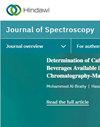太赫兹技术检测三七粉掺假
IF 2.1
4区 化学
Q4 BIOCHEMICAL RESEARCH METHODS
引用次数: 1
摘要
采用太赫兹时域光谱(THz-TDS)联合化学计量技术对三七粉中类似物质的掺假进行了检测。实验共制备了四种样品,三种掺假样品分别为掺入莪术粉的三七粉、掺入小麦粉的三七粉和掺入米粉的三七粉。掺假浓度范围为5% ~ 60%,掺假浓度间隔为5%,另一样品为三七纯粉。建模集和预测集按类别按3:1划分。采用无信息变量消除法(UVE)和逐次投影法(SPA)提取模型的特征信息;结合反向传播神经网络(BPNN),分别建立了UVE-BPNN和SPA-BPNN定性模型。模型结果表明,UVE-BPNN模型效果较好;UVE-BPNN预测集的分类准确率为95%。然后,利用最小二乘支持向量机(LS-SVM)算法和偏最小二乘(PLS)算法建立定量分析模型。模型结果表明,在莪术粉和小麦粉的定量分析模型中,LS-SVM模型效果较好,预测相关系数(RP)分别为0.90和0.93,预测均方根误差(RMSEP)分别为0.072和0.068。在米粉的定量分析模型中,PLS模型效果较好,RP为0.94,RMSEP为0.06。结果表明,太赫兹tds和化学计量相结合的方法可以快速、准确、无损地检测三七粉中类似物质的掺假情况。本文章由计算机程序翻译,如有差异,请以英文原文为准。
Detection of Adulteration of Panax Notoginseng Powder by Terahertz Technology
The combined terahertz time-domain spectroscopy (THz-TDS) and chemometric technology is used to detect the adulteration of similar substances in Panax notoginseng powder. Four kinds of samples are prepared in the experiment, three kinds of adulterated samples are Panax notoginseng powder adulterating with zedoary turmeric powder, Panax notoginseng powder adulterating with wheat flour, and Panax notoginseng powder adulterating with rice flour, respectively. The values of adulterated concentration are from 5% to 60%, the interval of adulterated concentration is 5%, and the other sample is pure Panax notoginseng powder. The modeling and prediction sets are divided by 3 : 1 by class. The feature information of models is extracted by elimination of uninformative variable (UVE) method and successive projection algorithm (SPA); combining with back propagation neural network (BPNN), the UVE-BPNN and SPA-BPNN qualitative models are established, respectively. The model’s results show that the UVE-BPNN model is better; the classification accuracy of the prediction set of UVE-BPNN is 95%. Then, the least square support vector machine (LS-SVM) algorithm and partial least square (PLS) algorithm are used to establish the quantitative analysis model. The model’s results show that the LS-SVM model is better among the quantitative analysis models of zedoary turmeric powder and wheat flour, the correlation coefficient of prediction (RP) is 0.90 and 0.93 of LS-SVM, respectively, and the root mean square error of prediction (RMSEP) of LS-SVM is 0.072 and 0.068, respectively. Among the quantitative analysis models for rice noodles, the PLS model is better, with the RP of 0.94 and RMSEP of 0.06. The results show that the combined THz-TDS and chemometric technology can be used to determine the adulteration of similar substances in Panax notoginseng powder quickly, accurately, and nondestructively.
求助全文
通过发布文献求助,成功后即可免费获取论文全文。
去求助
来源期刊

Journal of Spectroscopy
BIOCHEMICAL RESEARCH METHODS-SPECTROSCOPY
CiteScore
3.00
自引率
0.00%
发文量
37
审稿时长
15 weeks
期刊介绍:
Journal of Spectroscopy (formerly titled Spectroscopy: An International Journal) is a peer-reviewed, open access journal that publishes original research articles as well as review articles in all areas of spectroscopy.
 求助内容:
求助内容: 应助结果提醒方式:
应助结果提醒方式:


